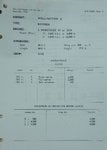Shortround6
Lieutenant General
To fit all those 250lb bombs?
Think about it.
2in of clearance between the nose of the torpedo and the bomb bay, 2in between the torpedoes and 2in from the rear of the 2nd torpedo and the back of the bomb bay. Of course this wouldn't be the first time the right hand (aircraft design) didn't know what the left hand (torpedo design) was doing.
A Wellington could carry two torpedoes.
Think about it.
2in of clearance between the nose of the torpedo and the bomb bay, 2in between the torpedoes and 2in from the rear of the 2nd torpedo and the back of the bomb bay. Of course this wouldn't be the first time the right hand (aircraft design) didn't know what the left hand (torpedo design) was doing.
A Wellington could carry two torpedoes.

